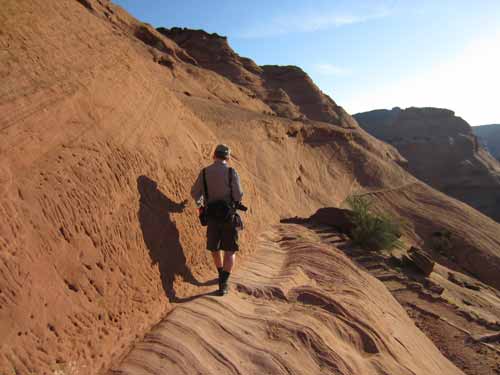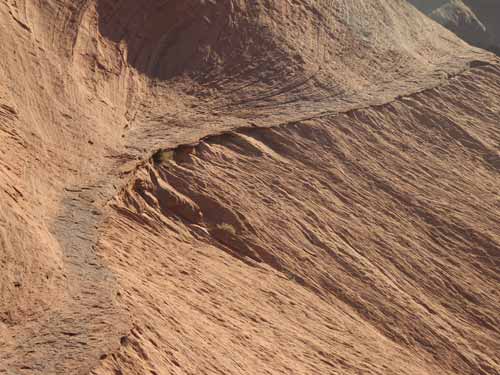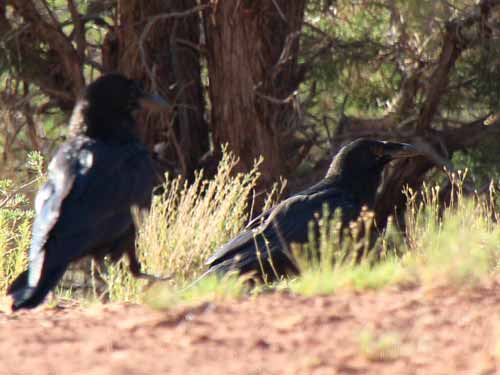Canyon de Chelly ("de Shay") National Monument, established in 1931 within the Navajo Reservation, contains a 26-mile canyon with cliff walls ranging from 30 to 1,000 feet. Its name is the Spanish-English corruption of the Navajo name for the canyon... Tséyi' (pronounced SAY-ih), meaning Rock Canyon.

The canyon splits into Canyon de Chelly (on the south) and Canyon del Meurto (north).
Archeological finds show that people have lived in the canyon for nearly 5,000 years. The earliest inhabitants left only images etched or painted on the walls. Later, people known as the Basketmakers built homes high up on cliff ledges. They lived in small groups and grew corn and beans. They were followed by the ancestral Pueblo people (ancestors of the Hopi and some other tribes). Originally in school, we learned them as the Anasazi. But this term has fallen out of favor, mostly because it is the Navajo word for "ancient ones"... but more correctly translated "ancestors of our enemies." They built multi-storied villages. Around the year 1300, they moved away. Finally the Navajo came, pushing out other migrating tribes, and claimed the canyon as their home.
Archaic: 2500 - 200 BC
Basketmaker: 200 BC - 750
Pueblo: 750 - 1300
Hopi: 1300 - 1600
Navajo: 1700 - 1863 (the Long Walk)

Navajo riding east, summer 1904, by Edward Curtis
All of the trails into the canyon require a guide... except for the White House Ruins trail. And so, at 7:30 am, we began the hike down.
The hike down wasn't too bad... the air was still cool and we were mostly in shadow, and the rock was dry (it was easy to see how it could be extremely treacherous when wet). Lizards darted everywhere. Once down from the main cliff, we crossed a small plateau, then made the final decent to the flat valley below.

The trail one-way is 1 1/2 miles...

... but round-trip is 2.5? Is that lost half mile in the Twilight Zone?

Walking along the rim to the trailhead

Arrows carved in the rock led the way.

A view of the trail

Our destination... the canyon floor far below.

The trail

This is an example where I was glad it was dry...

... for here was the view down.

It was hard to tell if these were old trails...

... or just naturally funky rocks.

Amazing rock patterns...

... and colors.

Caves help create a creepy skull-like shape!



A Side-blotched Lizard demonstrates some perfect camouflage!

The glare!

From the first plateau. The arrows point to people, to give a sense of scale.



A California Rock Squirrel also gives us the evil eye.

A family of noisy ravens made their way though the shrubbery.

Desert plants

Light had not yet reached this part of the canyon.

A final tunnel leads to the valley floor.
It was an easy walk to the tall cliff into which the White House dwellings were carved. The vendors were still busy setting up for the day.

A small bridge crossed Chinle Wash. The dwellings were in the bottom of the cliff directly ahead.

Silverleaf Nightshade is a common desert weed. A member of the Solanaceae family (the nightshade or potato family), its leaves and fruit are toxic at all stages of maturity.


Prickly pear cactus

It was still too early for most of the vendors, but a few were already getting into place.

The ruins were protected by a high fence. The only way we could get any pictures was to stand on a nearby rock.

Unlike many cliff dwellings, this one was close to the valley floor.
White House ruins gets its name from the long wall in the upper dwelling which was covered with white plaster. At its peak, the village housed about 100 people in some 60 rooms constructed of stone blocks with mud mortar. They farmed on the canyon floor... crops such as corn, beans, squash and cotton. They made yucca sandals, turkey feather robes, fine cotton cloth, baskets and pottery with elaborate decorations.

Remains of the white wall, covered with graffiti from the late 1800's and early 1900's

Numerous drawings covered the surrounding cliff walls. These are pictographs, which are painted onto the rock as opposed to petroglyphs which are carved.






The ruins were swarmed with rock squirrels.

Heading back to the path up before the heat of the day kicked in.


A good example of desert varnish (the black) with some pieces broken off to show the original rock color.

Amazing rock layers!

The textures were anything but soft and smooth!

Starting back up the path


